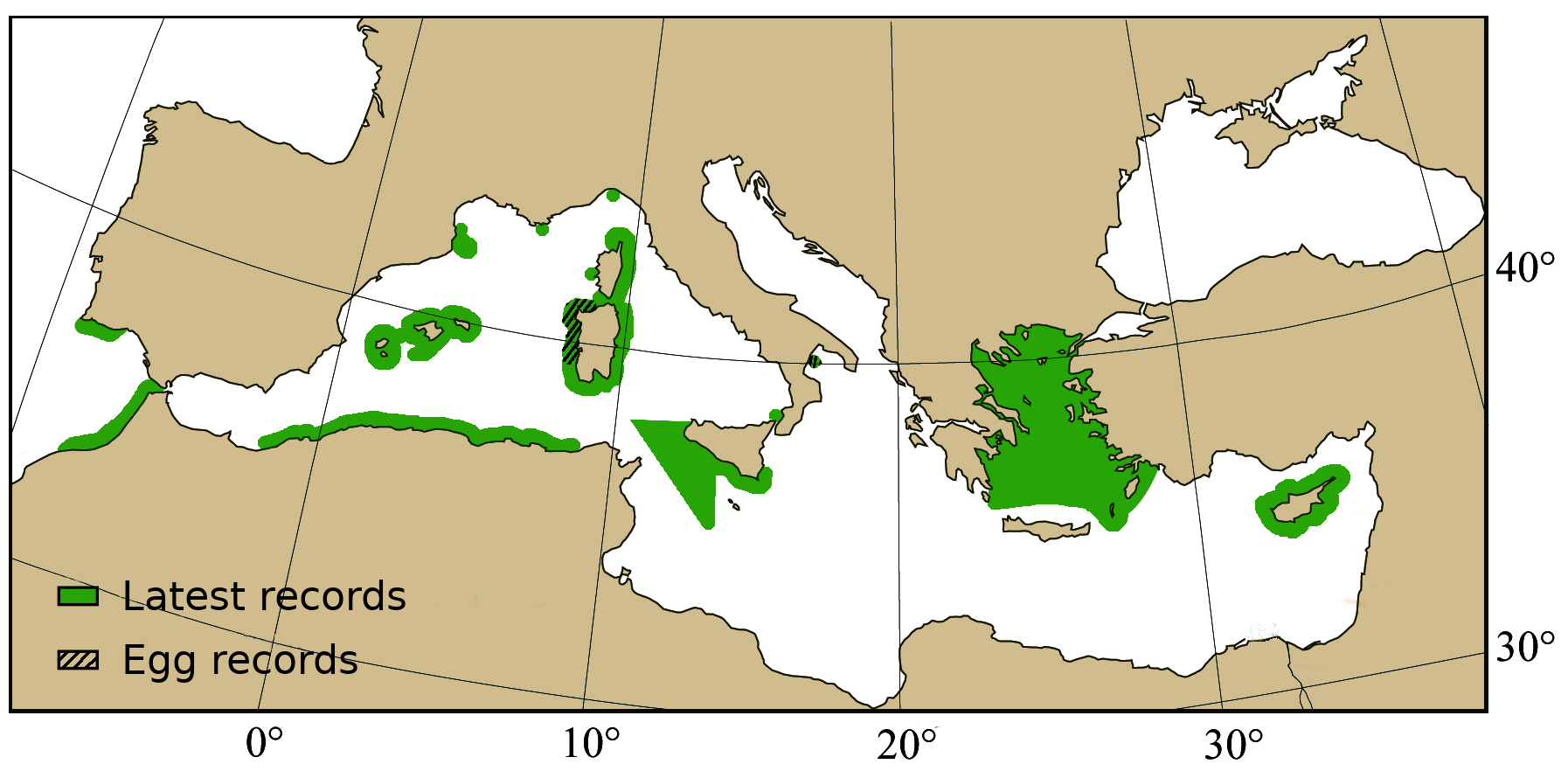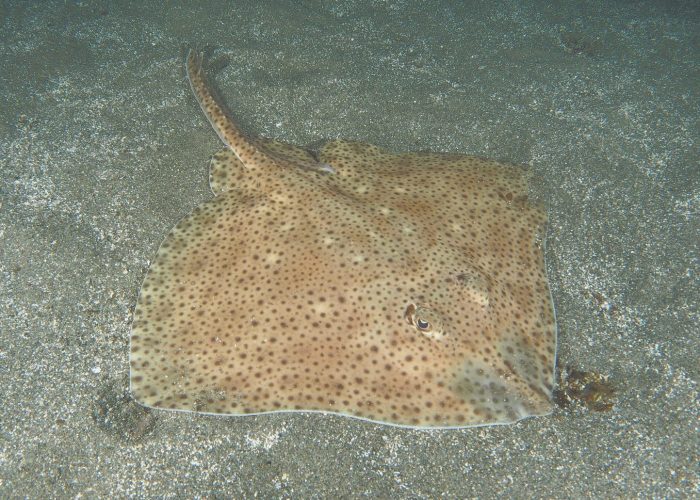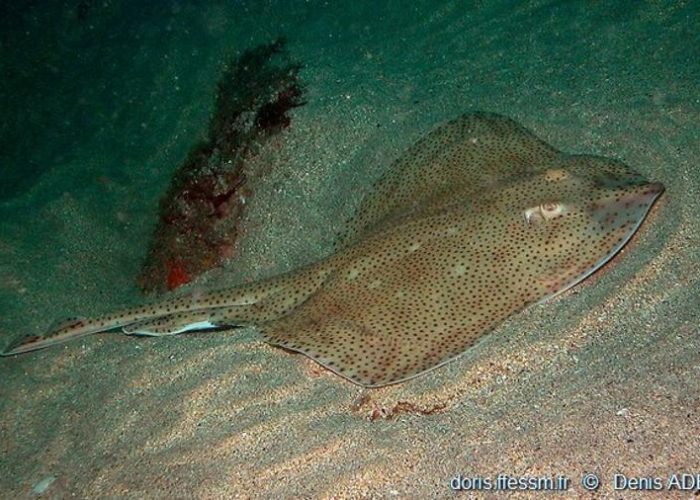Raja brachyura
Common name : Blonde Skate
Order: Rajiformes
Family: Rajidae
Synonyms: None
Misidentifications: Raja polystigma, Raja montagui
Short description
Medium-sized skate. Rhomboid disc slightly wider than long with sinuous anterior margins. Short rostrum, rounded at its extremity. Pectoral fins with clear angles on the lateral side. Upper surface entirely prickly (except in juveniles). Underside only prickly along front margins of disc. Separate orbital thorns. Regular median row of 40-45 thorns in juveniles and adult females, interrupted on back in males. Short and thick tail.
Color: Ochre dorsal surface, with numerous small dark spots to margins of disc. Sometimes light spots surrounded by black circles. White ventral surface.
Measurements:
- Disk width (DW): 40-80 cm (up to 125 cm)
- Total length (TL): up to 120 cm
- Weight: up to 14 kilos
Swimming pattern: Undulatory and pelvic fin locomotion (walking and punting).
Egg case
Rectangular shape with pointed horns at the corners. Deposited in a sandy bottom. Pronounced and rounded posterior apron, slightly longer and sturdy posterior apron. Short and sturdy posterior horns, thin and long anterior horns. Adhesive fibres attached to a pronounced lateral keel.
Fresh color: from reddish brown to greenish in the edges and the keels.
Size: 10-14.3cm length, 10-14.3cm wide.
Distinctive features:
- Developed aprons.
- Particularly long and thin anterior horns.

Raja: Long posterior horns. Anterior horns length less than twice the posterior.
Rajiformes / Rajidae: Rectangular egg-case, width inferior or equal to two times the capsuleRectangular egg-case, width no greater than twice the capsule length.
Biology / Ecology
Feeds on all kinds of benthic animals. Large specimens more piscivorous while juveniles feed on small crustaceans (amphipods, natantids).
Reproduction: Oviparous. Size at maturity (TL): 80-90 cm. Eggs per year: 30-70. Embryos development: ~ 7 months. Size at birth (TL): 16-18 cm.
Habitat: Benthic in inshore waters. Occurs on soft substrates, mainly on sand and sand-rock bottoms. Depth: 10-900, but mainly from 10-300 m.
Distinguishing characteristics
- Short and robust tail.
- Black dots reach the margins of the disc, contrary to R. montagui.
Rajiformes / Rajidae: Depressed body. Circular to rhombic disc. Tail well demarcated from disc.
Distribution
Worldwide: From the Northeastern Atlantic to Northwestern Africa, including the Western Mediterranean Sea. Absent from Black Sea.
Mediterranean:
- Occurrence: Occasional.
- Latest records: Cyprus (2018-2022), Sardinia (2017), Portugal (1986-2017), Atlantic – Morocco (2016), Aegean Sea (2012-2015), Balearic Sea (2012-2015), Sicily (2012-2015), Calabria -Italy (2011, with eggs), Algeria (2003-2004).

Any recent observation not on the map?
Contact us!
Conservation
Threats: Bycatch of semi industrial (Spain) and artisanal (Morocco and Greece) fisheries with bottom trawls, gill nets and long lines.
Protection level:
- Mediterranean: Near Threatened (IUCN 2016, last assessment: 2016)
- Global: Near Threatened (IUCN 2009, last assessment: 2008)
Key references
- Carpentieri P., Nastasi A., Sessa M., Srour A. 2021. Incidental catch of vulnerable species in Mediterranean and Black Sea fisheries – A review. General Fisheries Commission for the Mediterranean – Studies and Reviews 101: I-317.
- Follesa M. C., Marongiu M. F., Zupa W., Bellodi A., Cau A., Cannas R., Colloca F., Djurovic M., Isajlovic I., Jadaud A., Manfredi C., Mulas A., Peristeraki P., Porcu C., Ramirez-Amaro S., Salmerón Jiménez F., Serena F., Sion L., Thasitis I., Cau A., Carbonara P. 2019. Spatial variability of Chondrichthyes in the northern Mediterranean. Scientia Marina 83(S1): 81-100.
- Giovos I., Serena F., Katsada D., Anastasiadis A., Barash A., Charilaou C., Hall-Spencer J.M.,Crocetta F.,Kaminas A., Kletou D, Maximiadi M., Minasidis V., Moutopoulos D.K., Aga-Spyridopoulou R.N., Thasitis I., Kleitou P. 2021. Integrating literature, biodiversity databases, and citizen-science to reconstruct the checklist of Chondrichthyans in Cyprus (Eastern Mediterranean Sea). Fishes 6(3): 24.
- Marongiu M.F., Porcu C., Bellodi A., Cannas R., Cau A., Cuccu D., Mulas A., Follesa M.C. 2017. Temporal dynamics of demersal chondrichthyan species in the central western Mediterranean Sea: The case study in Sardinia Island. Fisheries Research 193: 81-94.
- O’Keefe M., Bengil EG., Palmer JL, Beton D, Çağlar Ç., Godley B.J, Özkan M., Snape R.T.E., Broderick A.C. 2023. Diversity and distribution of elasmobranchs in the coastal waters of Cyprus: using bycatch data to inform management and conservation. Front. Mar. Sci. 10: 1181437.
- Porcu C., Bellodi A., Cannas R., Marongiu M.F., Mulas A., Follesa M.C. 2015. Life-history traits of a commercial ray, Raja brachyura from the central western Mediterranean Sea. Mediterranean Marine Science: 90-102.
- Porcu C., Marongiu M.F., Bellodi A., Cannas R., Cau A., Melis R., Mulas A., Soldovilla G., Vacca L., Follesa M.C. 2017. Morphological descriptions of the eggcases of skates (Rajidae) from the central-western Mediterranean, with notes on their distribution. Helgoland Marine Research 71(1): 1-14



